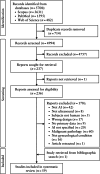Application of artificial intelligence to ultrasound imaging for benign gynecological disorders: systematic review
- PMID: 39888598
- PMCID: PMC11872345
- DOI: 10.1002/uog.29171
Application of artificial intelligence to ultrasound imaging for benign gynecological disorders: systematic review
Abstract
Objective: Although artificial intelligence (AI) is increasingly being applied to ultrasound imaging in gynecology, efforts to synthesize the available evidence have been inadequate. The aim of this systematic review was to summarize and evaluate the literature on the role of AI applied to ultrasound imaging in benign gynecological disorders.
Methods: Web of Science, PubMed and Scopus databases were searched from inception until August 2024. Inclusion criteria were studies applying AI to ultrasound imaging in the diagnosis and management of benign gynecological disorders. Studies retrieved from the literature search were imported into Rayyan software and quality assessment was performed using the Quality Assessment Tool for Artificial Intelligence-Centered Diagnostic Test Accuracy Studies (QUADAS-AI).
Results: Of the 59 studies included, 12 were on polycystic ovary syndrome (PCOS), 11 were on infertility and assisted reproductive technology, 11 were on benign ovarian pathology (i.e. ovarian cysts, ovarian torsion, premature ovarian failure), 10 were on endometrial or myometrial pathology, nine were on pelvic floor disorder and six were on endometriosis. China was the most highly represented country (22/59 (37.3%)). According to QUADAS-AI, most studies were at high risk of bias for the subject selection domain (because the sample size, source or scanner model was not specified, data were not derived from open-source datasets and/or imaging preprocessing was not performed) and the index test domain (AI models were not validated externally), and at low risk of bias for the reference standard domain (the reference standard classified the target condition correctly) and the workflow domain (the time between the index test and the reference standard was reasonable). Most studies (40/59) developed and internally validated AI classification models for distinguishing between normal and pathological cases (i.e. presence vs absence of PCOS, pelvic endometriosis, urinary incontinence, ovarian cyst or ovarian torsion), whereas 19/59 studies aimed to automatically segment or measure ovarian follicles, ovarian volume, endometrial thickness, uterine fibroids or pelvic floor structures.
Conclusion: The published literature on AI applied to ultrasound in benign gynecological disorders is focused mainly on creating classification models to distinguish between normal and pathological cases, and on developing models to automatically segment or measure ovarian volume or follicles. © 2025 The Author(s). Ultrasound in Obstetrics & Gynecology published by John Wiley & Sons Ltd on behalf of International Society of Ultrasound in Obstetrics and Gynecology.
Keywords: artificial intelligence; gynecology; machine learning; ultrasonography.
© 2025 The Author(s). Ultrasound in Obstetrics & Gynecology published by John Wiley & Sons Ltd on behalf of International Society of Ultrasound in Obstetrics and Gynecology.
Figures
References
-
- American College of Obstetricians and Gynecologists . ACOG Practice Bulletin No. 83: management of adnexal masses. Obstet Gynecol. 2007;110(1):201‐214. - PubMed
-
- Exacoustos C, Manganaro L, Zupi E. Imaging for the evaluation of endometriosis and adenomyosis. Best Pract Res Clin Obstet Gynaecol. 2014;28(5):655‐681. - PubMed
-
- Guerriero S, Ajossa S, Garau N, Alcazar JL, Mais V, Melis GB. Diagnosis of pelvic adhesions in patients with endometrioma: the role of transvaginal ultrasonography. Fertil Steril. 2010;94(2):742‐746. - PubMed
-
- Mais V, Guerriero S, Ajossa S, Angiolucci M, Paoletti AM, Melis GB. The efficiency of transvaginal ultrasonography in the diagnosis of endometrioma. Fertil Steril. 1993;60(5):776‐780. - PubMed
-
- Kondagari L, Kahn J, Singh M. Sonography gynecology infertility assessment, protocols, and interpretation. StatPearls; 2023. - PubMed
Publication types
MeSH terms
LinkOut - more resources
Full Text Sources


